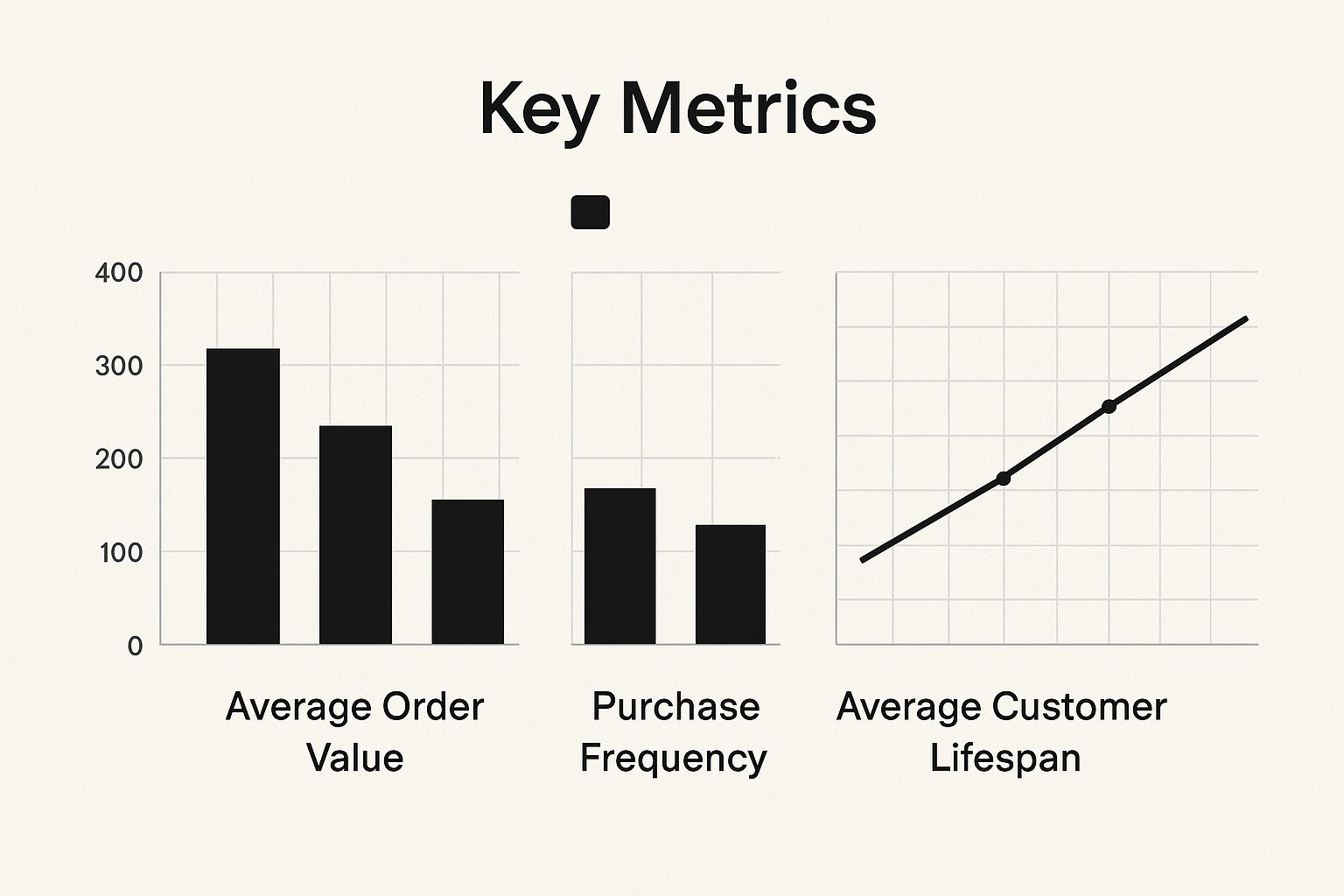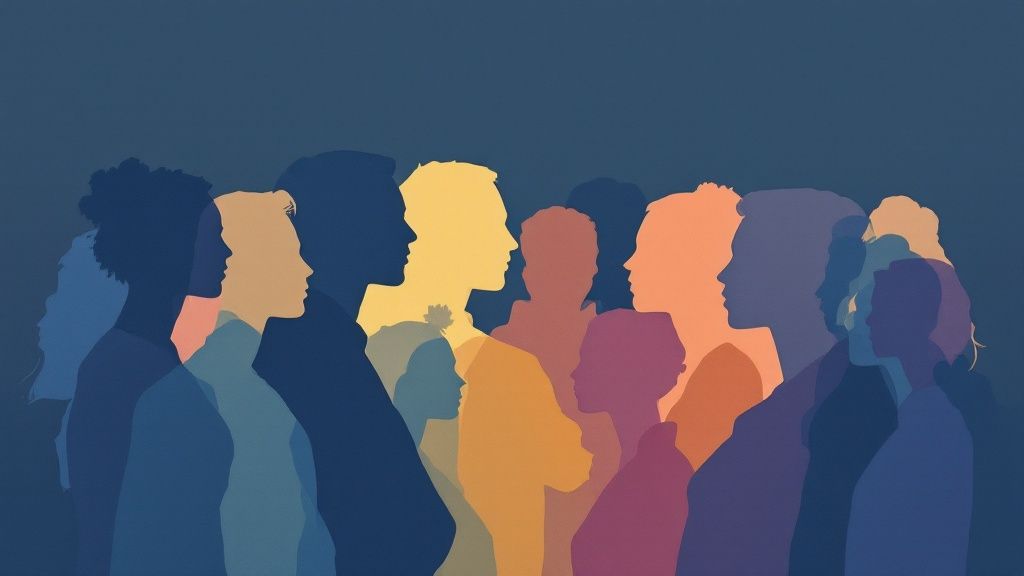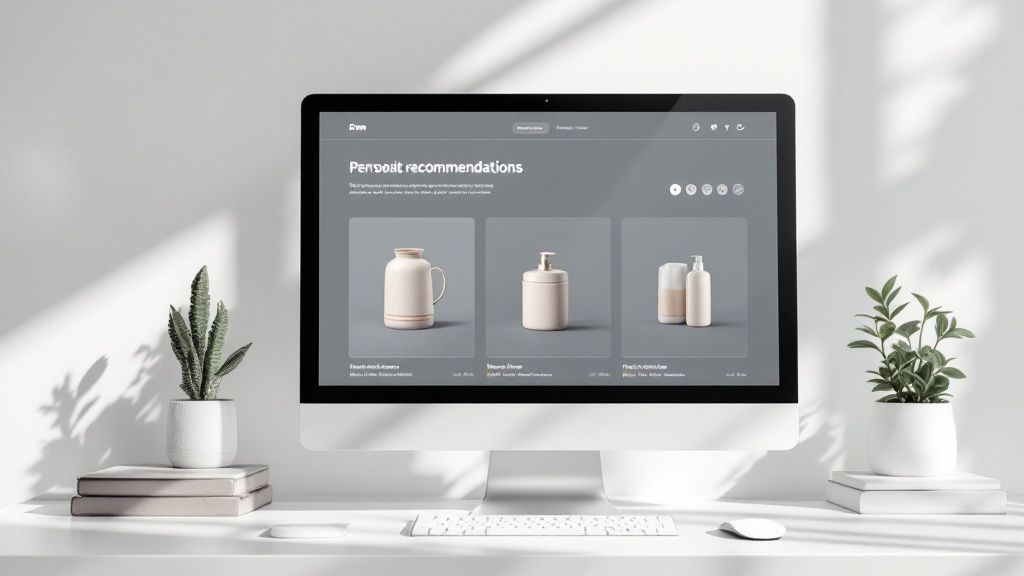Create Your Own AI Girlfriend 😈
Chat with AI Luvr's today or make your own! Receive images, audio messages, and much more! 🔥
4.5 stars

Improving customer lifetime value is really all about making a crucial shift in your thinking. Instead of chasing one-off sales, you start building long-term, profitable relationships. This means pulling the right levers to increase how often people buy, how much they spend each time, and how long they stick around, ultimately turning casual shoppers into your most loyal fans.
When you nail this, you’re not just making more money; you're building a far more stable and predictable revenue stream.
Your Engine for Sustainable Growth
It’s so easy to get stuck on the "acquisition treadmill." Businesses pour tons of money into finding new customers, often forgetting about the goldmine they’re already sitting on: their current customer base. Focusing on customer lifetime value (CLV) isn't just about another metric to track. It's a complete shift in your business philosophy, where you prioritize nurturing relationships over chasing quick, transactional wins.
And the impact is huge. Research from Bain & Company shows that a tiny 5% increase in customer retention can boost profits anywhere from 25% to 95%. That's not a typo. The reason is simple—it costs between 5 and 25 times more to bring in a new customer than to keep a current one happy.
Understanding the Levers of CLV
If you want to move the needle on CLV, you have to understand its core components. These are the main levers you can pull to directly influence the total value a customer brings to your business over time. I like to think of them as the foundational pillars of any lasting, profitable customer relationship.
The image below breaks down the key metrics: average order value, purchase frequency, and the average customer lifespan.

What this really shows is how small, consistent improvements in each of these areas can compound, leading to a massive lift in your overall CLV. It’s not about one big move; it's about a series of smart, targeted actions.
Here’s a quick rundown of the three primary levers:
- Average Order Value (AOV): This is simply the average amount a customer spends every time they check out. Smart upselling and cross-selling are your best friends here.
- Purchase Frequency: This tracks how often a customer comes back to buy from you over a set period. Think loyalty programs, targeted email campaigns, and timely reminders.
- Customer Lifespan: This measures the total time a person remains an active customer. To extend this, you need to deliver exceptional service and build a genuine sense of community.
By zeroing in on these three areas, you can create a repeatable system for increasing the long-term worth of every single customer. If you're looking for more ideas on building that kind of loyalty, check out our other guides on the Luvr AI blog.
CLV Growth Levers At a Glance
To make this even clearer, here's a simple table summarizing how these strategies connect directly to the core components of CLV.
| Strategy | Primary CLV Component Affected | Example Tactic |
|---|---|---|
| Upselling & Cross-selling | Average Order Value | Offering a premium version or complementary accessories at checkout. |
| Loyalty Programs | Purchase Frequency | A points-based system that rewards repeat purchases with discounts. |
| Personalization | Purchase Frequency & AOV | Sending targeted emails with product recommendations based on past behavior. |
| Exceptional Customer Service | Customer Lifespan | Proactive support and hassle-free returns that build trust. |
| Subscription Models | All Three | A monthly subscription that ensures recurring revenue and frequent engagement. |
Think of this table as your cheat sheet. When you're brainstorming new campaigns or initiatives, you can refer back to it to see exactly which lever you're trying to pull and how it all fits into the bigger picture of sustainable growth.
Building Your Data-Driven CLV Foundation

If you're serious about growing customer lifetime value, it all starts with one thing: truly knowing your customers. This goes way beyond just looking at what they bought and when. You have to get under the hood and understand the why behind their actions.
Your foundation isn't built on transactions. It's built on a complete picture of every single interaction they have with your brand.
Think about it. A customer browses your site, opens—or deletes—your emails, chats with customer support, and maybe leaves a review. Each touchpoint is a breadcrumb, a clue that tells you more about their satisfaction, their needs, and how likely they are to stick around.
To really move the needle on CLV, you have to connect these scattered dots into a clear story for each customer. Once you do that, you can stop guessing and start making smart decisions that actually resonate.
Creating a Single Customer View
Your secret weapon here is what's known as a single customer view (SCV). This is basically your command center—a unified profile that pulls together every scrap of data you have on an individual, from their very first visit to their latest support chat.
Without an SCV, your teams are flying blind. Marketing sends one message while customer service has a completely different conversation, leading to a clunky and impersonal experience for the customer.
Now, imagine your support agent sees that a customer was just looking at a specific product page or is part of your top loyalty tier. That context changes everything. It turns a generic support ticket into a meaningful, personalized conversation. That's how you make someone feel seen and valued.
According to a study from Twilio, recent economic uncertainty has pushed 67% of brands to shift their focus from acquiring new customers to retaining the ones they have. This makes a deep, data-driven understanding of your existing customer base more important than ever.
Building this unified view is the non-negotiable first step. It’s what lets you identify who your best customers are and pinpoint the exact behaviors that signal long-term loyalty.
Gathering the Data That Truly Matters
So, how do you build a powerful SCV? You need to cast a wide net and collect more than just the obvious financial metrics. The real magic often comes from behavioral and qualitative data.
Start pulling information from these key sources:
- Transactional Data: This is your baseline. Think Average Order Value (AOV), how often they buy, and which product categories they gravitate towards.
- Engagement Data: Look at email open rates, click-through rates, how long they spend on your site, and what content they interact with. This tells you what's catching their eye.
- Support Interactions: Dig into your support tickets. What are the common themes? How long does it take to resolve issues? This is a goldmine for finding and fixing pain points.
- Customer Feedback: Pay close attention to surveys, product reviews, and any direct feedback you receive. This qualitative data gives you the "why" behind the numbers.
Bringing all this information together usually means having the right tools in your corner. Platforms designed to centralize customer data and communication can paint a much clearer picture of who you're talking to. You can see how technology creates these detailed profiles by exploring the features of an AI-powered platform like Luvr AI.
By laying this data-driven groundwork, you turn a mountain of raw information into real, actionable insights. From there, you're perfectly set up to create the kind of personalized experiences that build lasting relationships and drive lifetime value through the roof.
Using Personalization to Deepen Customer Engagement

With a solid data foundation in place, you can finally stop shouting generic messages into the void and start having real, one-on-one conversations with your customers. That's what personalization is all about—using what you know to create experiences that feel like they were made just for them. It’s the difference between a brand that just sells stuff and a brand that actually gets its customers.
But we have to move past the simple stuff, like just dropping a first name into an email subject line. To really improve customer lifetime value, your personalization needs to anticipate a customer's needs and meet them exactly where they are in their journey. This is how you make them feel seen and understood, which is the absolute bedrock of long-term loyalty.
Beyond Basic Personalization Tactics
To forge these deeper connections, you need strategies that are dynamic and react to how customers behave in real-time. This is where your unified customer data becomes your superpower, letting you deliver the perfect message at the perfect moment.
Here are a few tactics that actually work:
- Dynamic Product Recommendations: Don't just show everyone the same "bestsellers" list. Instead, feature products based on an individual’s browsing history, previous purchases, or even things they’ve abandoned in their cart. It shows you’re paying attention.
- Behavior-Triggered Content: Set up automated messages based on specific actions. For instance, if someone looks at the same product page three times but doesn't buy, why not send them a helpful guide about it or a small, targeted discount?
- Customized Offers: Stop sending the same promotion to everyone. A first-time customer could get a welcome discount, while you might give a loyal VIP early access to a new collection.
These kinds of interactions prove you’re not just another faceless company. You're a partner who understands their preferences, giving them every reason to stick around.
Personalization isn't just a "nice-to-have" anymore; it's a core expectation. When customers feel like you understand them, over 82% are more likely to buy from you again. That’s how you turn a single sale into a lasting relationship.
AI-Powered Personalization in Action
Calculating Customer Lifetime Value (CLV) has come a long way from the simple spreadsheets of the past. Today, it’s all about sophisticated AI-driven analytics. Modern AI models pull in all sorts of data—from social media sentiment to broad market signals—to create incredibly precise forecasts of what a customer is worth.
Tools like Customer.io and Patagon AI are at the forefront of this shift, giving businesses the power to deliver highly personalized experiences and accurately predict future CLV. You can learn more about how AI is revolutionizing customer marketing on SuperAGI.com.
Platforms like Customer.io are built to automate these complex interactions at scale, so you can connect with thousands of customers as if you were talking to each one individually.
This is what it looks like in practice. The visual workflow builder lets you map out intricate customer journeys based on real-time data and user behavior. With this kind of tech, you can send hyper-relevant messages across email, SMS, and push notifications—all without a human lifting a finger. It's this intelligent automation that makes deep, meaningful personalization a reality for any brand.
Loyalty Programs Should Build Relationships, Not Just Transactions
Let's be honest, most loyalty programs are just glorified discount cards. They're a marketing tactic, sure, but they rarely create actual loyalty. To really boost customer lifetime value, you have to think bigger. You need to turn one-time buyers into genuine brand advocates.
A great loyalty program makes customers feel like they're part of an exclusive club—like insiders who get special treatment. The goal isn't just to bribe them into their next purchase. It's about building a sense of belonging that simple discounts can't buy. The real magic happens when you offer perks that money can't buy, like early access to new products, members-only content, or invitations to special events. That's what builds an emotional connection and keeps people coming back for years.
Go Beyond the Basic "Points for Purchase" Model
The old "spend more, get points" system feels tired and impersonal. It's a one-way street. To build a real connection, your program has to reward customers for their engagement, not just their spending. This shows you value everything they bring to the table, from their social media shout-outs to their product reviews.
Think about shaking things up with a different approach:
- Tiered Programs: Everyone loves a little status. Create membership levels that customers can climb to unlock better perks. It creates a feeling of achievement and exclusivity. A beauty brand could offer standard members free samples, but give top-tier "VIPs" a personal consultation with a pro stylist.
- Community-Based Rewards: Build a community around your brand by rewarding customers for things like writing reviews, sharing your content, or joining a forum discussion. This not only makes them feel more connected but also creates a treasure trove of user-generated content for you.
- Subscription Perks: Roll your loyalty benefits right into a subscription model. Amazon Prime is the masterclass here. The value goes way beyond free shipping—you get streaming, exclusive deals, and more, making the membership feel essential.
This shift towards rewarding genuine engagement is why the loyalty market is exploding. It was valued at $13.31 billion in 2024 and is on track to hit a staggering $41.21 billion by 2032. Businesses are finally realizing that true loyalty is about emotional connection, not just repeat sales. You can dig into more of the data with these customer loyalty trends from Antavo.
Create Perks People Actually Want
The key to a loyalty program that works is offering rewards your customers truly care about. Generic perks get you generic engagement. You need to craft offers that reflect your brand and what your specific audience finds valuable.
A well-designed loyalty program should feel less like a transaction and more like a relationship. It answers the customer's unspoken question: "What's in it for me beyond the product?" The best answers often have nothing to do with price.
For instance, a gaming company could give its most dedicated players exclusive in-game items or a spot in the next beta test. A coffee subscription service could host a virtual tasting session with their head roastmaster for top-tier members.
These are the kinds of unique, memorable experiences that reinforce why a customer chose you over a competitor. When you design a program that offers real value and fosters a sense of community, you’ve built a powerful engine for driving customer lifetime value.
Turning Customer Service into a Retention Powerhouse

We often think of customer service as a defensive move—something you have to do when a customer has a problem. But that’s a shortsighted view that leaves a ton of opportunity on the table. The brands that truly get it know that support isn't just about fixing what's broken; it's about cementing trust with every conversation.
If you can shift your perspective, you can turn your support team from a reactive department into a proactive engine that drives customer lifetime value sky-high. This is about more than just closing tickets. It's about actively looking for ways to make every customer's experience better.
Suddenly, every support interaction becomes a golden opportunity to strengthen that relationship. You're making customers feel heard and valued, which is what keeps them coming back.
From Reactive Fixes to Proactive Engagement
The secret sauce to a killer retention strategy is getting ahead of your customers' needs. Instead of waiting for questions to roll in, your team should be focused on making sure they never have to be asked in the first place. This means you need a rock-solid understanding of where people get stuck.
Think about it. If you know that a new product has a slightly confusing setup, don't wait for the frustrated emails. Get out in front of it. Create a simple, clear tutorial video and email it to every new buyer.
What if a shipping delay is unavoidable? Tell customers immediately, apologize, and offer a small gesture, like a discount on their next purchase. It’s a small shift that makes a world of difference. It shows you value their time, not just their money.
Exceptional customer support is your ultimate retention tool. When customers feel like you truly understand them and their needs, over 82% are more likely to buy from you again, turning a simple support interaction into a long-term loyalty driver.
Empowering Your Support Team to Deliver Excellence
Your support agents are on the front lines, and they need the right tools and the authority to create those "wow" moments. Nothing kills a customer's vibe faster than a support agent who is shackled by rigid scripts or has to escalate every tiny issue up the chain.
Empowering your team means giving them the wiggle room to make smart decisions for the customer. This could be as simple as issuing a replacement without needing a manager's sign-off or proactively crediting an account after a minor service disruption.
To really nail this, your team needs a complete picture of who they're talking to. This means giving them easy access to:
- Complete purchase history: What do they like? How long have they been a customer?
- Previous support interactions: Nobody likes repeating themselves.
- On-site behavior: Did they just abandon a cart or look at a specific product page?
This kind of context is what allows your agents to ditch the generic, canned responses and offer solutions that are genuinely helpful and personal. If you want to dive deeper into building a world-class customer experience, you can find a ton of practical strategies in our comprehensive guides on support.
When your team has both the data and the autonomy they need, they stop being mere problem-solvers and become true relationship-builders. And that’s a direct line to a higher customer lifetime value.
Answering Your Top Questions About Customer Lifetime Value
When you start digging into CLV, a few common questions always seem to pop up. Let's get them answered so you can move forward with confidence and a clear plan.
Where Should I Start if My Budget Is Limited?
This is a great question, and the answer is simpler than you might think. If you're tight on cash, forget about pouring money into expensive acquisition campaigns for a while.
Your absolute best investment is focusing on the customers you already have. The goal is to deliver a customer experience that's so good, they can't help but stick around.
You don't need a huge budget for this. Small, thoughtful actions often make the biggest difference. Think about:
- Personalized follow-up emails: Don't just send the standard "thanks for your order." Follow up a week later to ask how they're enjoying the product or share a pro tip on how to get the most out of it.
- Active listening on social media: When someone mentions your brand, jump in. Respond to comments and questions quickly and personally. It shows a real human is listening and that you genuinely care.
- Stellar customer support: Give your support team the freedom to solve problems effectively, maybe even generously. A single fantastic support experience can easily turn a frustrated customer into your biggest fan.
These efforts cost more in time than money, but they forge the kind of emotional connections that are the foundation of true loyalty and a higher CLV.
How Often Should I Be Calculating CLV?
There's no single, universal answer here—it really depends on the rhythm of your business. The key is to treat CLV as a vital health metric that you monitor consistently.
For most e-commerce or SaaS companies, a quarterly or semi-annual calculation is a solid rhythm. It's frequent enough to catch important trends but not so often that you get lost in the numbers.
If you're running a subscription service, you'll probably want to look at it monthly. This allows you to keep a close eye on churn and see the immediate impact of your retention efforts.
The real goal isn't just to get a number; it's to understand the story behind it. Are your recent personalization tactics actually increasing the average order value? Is that new loyalty program making people buy more often? Regular tracking gives you these crucial answers.
What Is a Good CLV to CAC Ratio?
Ah, the golden ratio. Knowing your Customer Lifetime Value (CLV) to Customer Acquisition Cost (CAC) ratio is one of the best ways to gauge the long-term health of your business.
While the exact numbers can shift between industries, a healthy and sustainable benchmark to aim for is at least 3:1.
In simple terms, this means for every dollar you spend to bring in a new customer, you should expect to generate at least $3 in value over their lifetime with your brand.
If your ratio is below 1:1, that’s a major warning sign—you're losing money on every new customer. A ratio hovering between 1:1 and 3:1 is profitable, but it signals that there's a lot of room to fine-tune your model for better, more stable growth.
Ready to create deep, personal connections that turn users into lifelong fans? Luvr AI provides the tools to build immersive, AI-driven relationships that foster true loyalty. Discover how to build your own custom AI companion.



